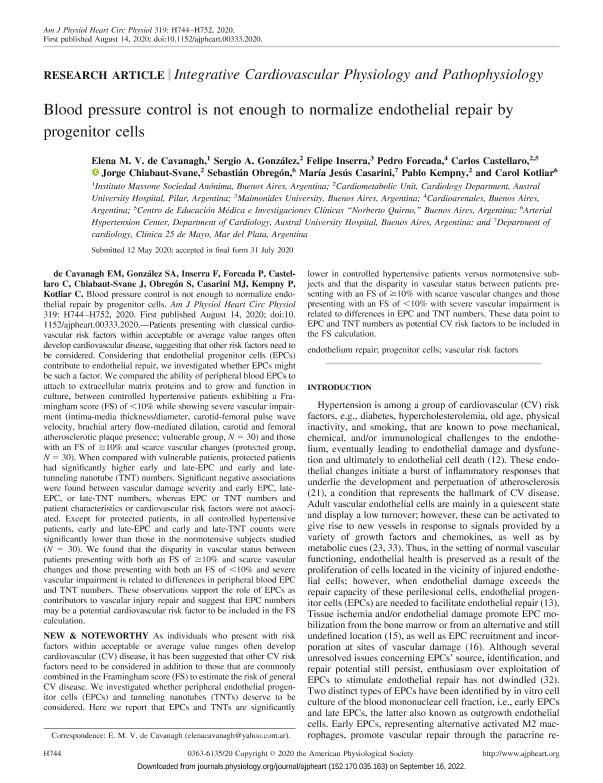Artículo
Blood pressure control is not enough to normalize endothelial repair by progenitor cells
De Cavanagh, Elena M. V.; González, Sergio Alejandro ; Inserra, Felipe; Forcada, Pedro; Castellaro, Carlos; Chiabaut Svane, Jorge; Obregón, Sebastián; Casarini, María Jesús; Kempny, Pablo; Kotliar, Carol Virginia
; Inserra, Felipe; Forcada, Pedro; Castellaro, Carlos; Chiabaut Svane, Jorge; Obregón, Sebastián; Casarini, María Jesús; Kempny, Pablo; Kotliar, Carol Virginia
 ; Inserra, Felipe; Forcada, Pedro; Castellaro, Carlos; Chiabaut Svane, Jorge; Obregón, Sebastián; Casarini, María Jesús; Kempny, Pablo; Kotliar, Carol Virginia
; Inserra, Felipe; Forcada, Pedro; Castellaro, Carlos; Chiabaut Svane, Jorge; Obregón, Sebastián; Casarini, María Jesús; Kempny, Pablo; Kotliar, Carol Virginia
Fecha de publicación:
11/2020
Editorial:
American Physiological Society
Revista:
American Journal of Physiology - Heart and Circulatory Physiology
ISSN:
0363-6135
Idioma:
Inglés
Tipo de recurso:
Artículo publicado
Clasificación temática:
Resumen
Patients presenting with classical cardiovascular risk factors within acceptable or average value ranges often develop cardiovascular disease, suggesting that other risk factors need to be considered. Considering that endothelial progenitor cells (EPCs) contribute to endothelial repair, we investigated whether EPCs might be such a factor. We compared the ability of peripheral blood EPCs to attach to extracellular matrix proteins and to grow and function in culture, between controlled hypertensive patients exhibiting a Framingham score (FS) of < 10% while showing severe vascular impairment (intima-media thickness/diameter, carotid-femoral pulse wave velocity, brachial artery flow-mediated dilation, carotid and femoral atherosclerotic plaque presence; vulnerable group, N = 30) and those with an FS of ≥ 10% and scarce vascular changes (protected group, N = 30). When compared with vulnerable patients, protected patients had significantly higher early and late-EPC and early and latetunneling nanotube (TNT) numbers. Significant negative associations were found between vascular damage severity and early EPC, lateEPC, or late-TNT numbers, whereas EPC or TNT numbers and patient characteristics or cardiovascular risk factors were not associated. Except for protected patients, in all controlled hypertensive patients, early and late-EPC and early and late-TNT counts were significantly lower than those in the normotensive subjects studied (N = 30). We found that the disparity in vascular status between patients presenting with both an FS of ≥10% and scarce vascular changes and those presenting with both an FS of < 10% and severe vascular impairment is related to differences in peripheral blood EPC and TNT numbers. These observations support the role of EPCs as contributors to vascular injury repair and suggest that EPC numbers may be a potential cardiovascular risk factor to be included in the FS calculation. New & Noteworthy: As individuals who present with risk factors within acceptable or average value ranges often develop cardiovascular (CV) disease, it has been suggested that other CV risk factors need to be considered in addition to those that are commonly combined in the Framingham score (FS) to estimate the risk of general CV disease. We investigated whether peripheral endothelial progenitor cells (EPCs) and tunneling nanotubes (TNTs) deserve to be considered. Here we report that EPCs and TNTs are significantly lower in controlled hypertensive patients versus normotensive subjects and that the disparity in vascular status between patients presenting with an FS of ≥ 10% with scarce vascular changes and those presenting with an FS of < 10% with severe vascular impairment is related to differences in EPC and TNT numbers. These data point to EPC and TNT numbers as potential CV risk factors to be included in the FS calculation.
Palabras clave:
ENDOTHELIUM REPAIR
,
PROGENITOR CELLS
,
VASCULAR RISK FACTORS
Archivos asociados
Licencia
Identificadores
Colecciones
Articulos(SEDE CENTRAL)
Articulos de SEDE CENTRAL
Articulos de SEDE CENTRAL
Citación
De Cavanagh, Elena M. V.; González, Sergio Alejandro; Inserra, Felipe; Forcada, Pedro; Castellaro, Carlos; et al.; Blood pressure control is not enough to normalize endothelial repair by progenitor cells; American Physiological Society; American Journal of Physiology - Heart and Circulatory Physiology; 318; 5; 11-2020; H744-H752
Compartir
Altmétricas



